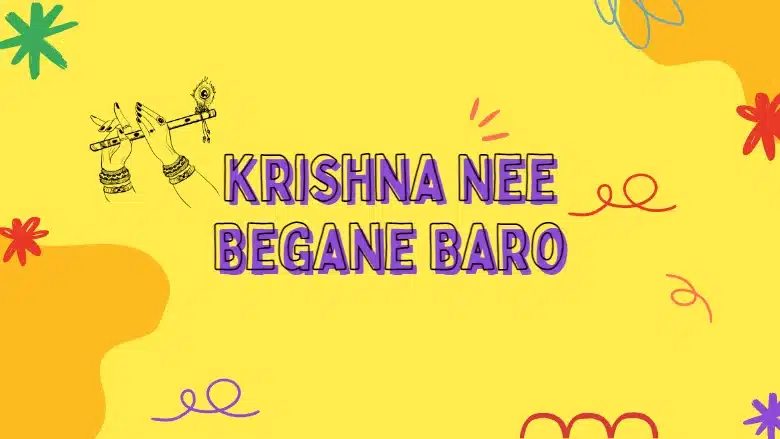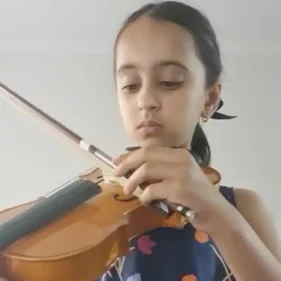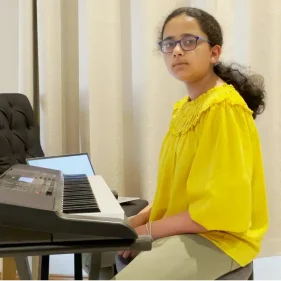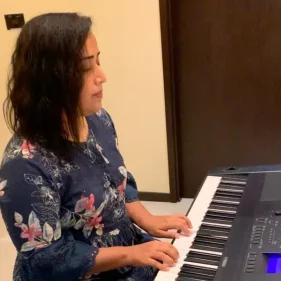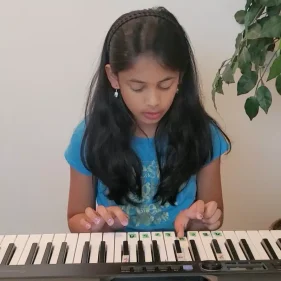There have been days when we yearn for Krishna- sometimes for his attention, sometimes for his blessings, and other times to look into his omnipresence to stare into his magical eyes! Krishna nee begane baro is Kanaka Dasa calling him out to grace us soon on all the devotees’ behalf. Let’s look into this divine beauty set in Yamunakalyani raga, Misra Chapu talam.
Raagam: Yamuna Kalyani
Taalam: Misra Chapu
Composer: Kanaka Dasa
Raga Yamunakalyani
This beautiful soundtrack is composed in Yamunakalyani evoking devotion in every swara heightening the spirit of courage. It falls under the 65th Melakartha Raga of the 72-raga system in Carnatic style of music. While most of the Carnatic music scales are derived in the South of India, this particular scale was borrowed from Hindustani Music prevalent in the North India. The ascending and descending notes of thai scale are as follows:
Arohanam: s r2 g3 p d2 n3 d2 S
Avarohanam: S n3 d2 p m2 g3 m1 r2 s
The swaras are Shadjam, Chathushruthi Rishabam, Anthara Gandharam, Panchamam, Prathi Madhyamam, Chathusrhuthi Daivatham, Kakali Nishadam.
Though Shuddha Madyamam appears in avarohanam, it should not be used often but sung between g3 and r2 following the shuddha madhyamam. Experts say that the jeeva swaras are Rishabam, Gandharam, Madhyamam, Daivatham and Nishadham, where the soul of the scale resides.
Krishna Nee Begane Baro Composer: Saint Vyasatheertha
The saint, philosopher of the 15th century, scholar and poet, Vyasatherrtha has many other names like Vyasaraja or Chandrikacharya, he is a original composer of Krishna nee begane baro . Born at Bannur located in now Mysore, Karnataka, he familiarised people with Dvaitha school of thought teaching topics in a realist’s point of view. He helped to resolve poverty issues by teaching people irrigation techniques in nearby villages. He propagated his philosophy by writing hymns using a pen-name called Krishna. Incidentally, this song is crafted using the same name, written originally by Vyasraja, one of the many other names he is referred to as throughout historical scriptures.
Krishna Nee Begane Thalam – Misra Chapu
Tap to the rhythm of Misra Chapu talam while you sway your heads to the melodious Krishna Nee Begane. Misra means mixing and chappu is derived from the Tamil word Chapippu that means slanting. The rhythm pattern is a unique mixture of Tisram + Chatusram, i.e., 3+ 4 or 4+ 3. The talam is an adaptation from South Indian folklore explained as follows:
Tha Ki Ta Tha Ka Dhi Mi
Counted as: Clap – 2 – 3 – Clap – 2 – 3 – 4 [If you count your rhythm as 1,2,3,4]
The Western equivalent is the 7⁄8 rhythm pattern which incidentally draws parallels with Bulgarian folk music too.
Original Composer of Krishna Nee Begane
We have critics tell us this song is originally composed by Vyasaraya which was followed by Kanakadasa who was his ardent disciple. The following are the Krishna nee begane baro lyrics in english, and tamil.
Krishna Nee Begane Baro Lyrics in English
Krishna Nee Begane Baro Begane Baro
Mukhavanne Toro Krishna Nee Begane Baro
Kalalandige Gejje, Neelada Bavuli
Neelavarnane Natyavanaduta Baro
Krishna Nee Begane Baro
Udiyalli Udigejje, Beralalli Ungura
Koralalli Haakida Vaijayantiya Maale
Krishna Nee Begane Baro
Kasi Pitambara, Kaiyalli Kolalu
Pusida Shreegandha Mayyolagamagama!
Krishna Nee Begane Baro
Tayige Bayalli Jagavannu Thorida
Jagadoddharaka Namma Udupi Shri Krishna
Krishna Nee Begane Baro
Krishna Nee Begane Baro Lyrics in Tamil
கிருஷ்ணா நீ பேகனே பாரோ
பேகனே பாரோ முகவன்னே தோரோ (கிருஷ்ணா)
காலா லந்திகே கெஜ்ஜே நீலத பாவோலி
நீலவர்ணத நாட்யா வாடுத பாரோ (கிருஷ்ணா)
உடியல்லி ஊடுகெஜ்ஜே பெரளல்லி உங்குர
கொரளோளு ஹாகித வைஜயந்தி மாலே (கிருஷ்ணா)
காசி பீதாம்பர கையல்லி கொளலூ
பூசித ஸ்ரீகந்த மையொள கிரலு (கிருஷ்ணா)
தாயிகே பாயல்லி ஜகவன்னு தோரித
ஜகதோத்தாரக நம்ம உடுப்பி ஸ்ரீ கிருஷ்ணா (கிருஷ்ணா)
There are also krishna nee begane lyrics in malayalam and hindi that you may like. Checkout this Krishna Nee Begane Baro vocal performance by Colonial Cousins.
Krishna Nee Begane Meaning
This timeless piece was originally composed by musician Vidyabhushana and has undeniably touched the hearts of millions across generations. The song serves as a plea to ask Lord Krishna for his grace and blessings in his presence. The Krishna nee begane baro meaning shows a soul’s yearning for spiritual connection and salvation. The lyrics overflow with devotion and are symbolism of significant love for Lord Krishna with a view of holding him powerful for captivating one’s heart.
The first line calls out to Krishna, asking him to come soon. The anupallavi explains about how the poet asks him to reach out soon (begane) and grace him with his presence by showing his enchanting face (Mukhavanthi).
We all know how beautiful, mesmerising and mystical the lord is who is always dressed up immaculately. The Charanam 1 talks exactly about the same. It talks about the pretty anklets on his feet, the sapphire bracelets on his arms. The armlet is an ornament that prevents your hands from moving freely holding onto your upper hand. It signifies the grip you need to have in life, despite having freewill and the poet asks his favourite god, Krishna to give him and his devotees the strength of restraint. Saint Vyasaraja calls Krishna out as the blue coloured one to come to him while dancing. The deeper context in this charanam is to note how Indian tradition always has a scientific explanation, some known and many unknown! Anklets that are worn by Indian women are a way to ward off evil and thus the saint asks the lord to help him clear his path from ill happenings.
The 2nd Charanam talks about the lord’s anklets with bells attached to it adorned in his waist along with rings of His fingers, the glimmering sacred Vijayanthi necklace on His neck. Interesting fact about the Vyjayanthimala (Vijayathi necklace) is its appearance emerging out of Ksheera Sagar (the milk ocean of Lord Vishnu) during a war between the devas and asuras along with many other precious artifacts. Mythology says that the person who wears it is always victorious in whatever he does. The saint describes Lord Krishna adorning this exquisite neck piece describing Krishna giving the joy of victory for those who can see him, as an expression of his devotion.
Charanam 3 explains about his blessed saffron cloth from Kashi and the flute he always holds onto with his body smeared with sandalwood paste that makes him smell so good wherever he goes. Kashi is one of the oldest cities of India which is now called the Banaras and it is every human’s blessings that will help them attain salvation if he breathes his last breath in Kashi. In the song’s context the poet is talking about people remembering Krishna on their deathbed. The flute being a mystical instrument is the lord’s favourite that has been proven to calm the human and demon’s minds. It is mentioned as part of the poet calling HIM to kill the beasts inside us and fill it with peace and sanctity.
Charanam 4 moves on to the Lord showing the universe to his mother when she asks him to open his mouth to check if He has eaten mud, shocking his mother. The song talks about how Udipi Krishna is the Omega of the universe’s beginning and end, completing this melodious, ever-loved song, Krishna nee begane baro.
Best Renditions of Krishna Nee Begane
If you are a ‘90s Kid you would definitely know this song as the remix of colonial cousins, a duo band comprising the virtuoso, Hariharan and the sassy Lesle Lewis who plays the guitar and a vocalist too. The original song was remade with the inclusion of English lyrics asking the God to come as Jesus, Allah or Krishna himself to save the people with time being the healer of ill experiences that are a part of life itself. Though it was released almost a decade ago, the song is eternal and applies even today.
The older version, i.e., the Carnatic version bears many profound names too including the flute version of Rajesh Cherthala, vocal performance by Ranjani and Gayatri at the 2019 Ekatvam Holi Music Festival, the ShutIn Concert Instrumental Jugalbandi, and Mahesh Raghvan & Team to name a few. Bharatanatyam performances by Rukmani Vijaykumar and Shobana Chandrakumar Pillai are most watched and admired who bring the life of Krishna with expressive movements.
In today’s date, one of the most celebrated instrumental versions is by the artist Karthik Iyer who is part of the famous band, Indo Soul. Played at many concerts, weddings and other events, this band has taken Krishna Nee Begane to the next level.
Final Thoughts
Whether it is Janmashtami or any other day, Krishna Nee Begane is a classic to bring peace to the listener. From longing to look at his beautiful face to fancying his magical life, this song in Yamuna Kalyani is a song that is evergreen. Have you listened to it yet?. Like krishna nee begane there is another beautiful devotional Carnatic song sojugada soju malligae that you may like it. New to singing classes and looking for Online Carnatic Music Classes, check our Live 1 to 1 Online Carnatic music Class. You can also try a free 30 minutes trial class to get an idea of our carnatic classes.
FAQs
Who wrote and composed “Krishna Nee Begane Baro”?
The song, Krishna Nee Begane Baro is written and composed by Vyasatheertha in Kannada language, set in Yamunakalyani raga enjoyed in Misra Chapu talam.
What is the meaning of the lyrics in “Krishna Nee Begane Baro”?
The meaning of Krishna Nee Begane Baro is asking Krishna to come soon in his full glory adorning anklets, waistband, Vaijayanti garland, in saffron-coloured Kashi cloth made of silk, with a flute in one hand and the enchanting smell of sandalwood paste following him wherever He goes. It is a song full of Bhakthi and also elaborates a famous story of Krishna showing his mother the universe when she asked him to open his mouth.
Who are some famous singers who have sung “Krishna Nee Begane Baro”?
Some of the renowned singers who performed Krishna Nee Begane Baro include Ranjani-Gayathri duo, and a modern rendition using technology by Magesh Raghavan and Team.
What is the significance of the song in Indian classical music?
The significance of Krishna Nee Begane in Carnatic music plays a profound role in propagating the Dvaita school of thought initiated by Madhavacharya saint in the 15th century. Composed by Vyasatheertha, this song imbibes so much devotion for Lord Krishna, it still resonates in all our souls.
Are there different renditions of “Krishna Nee Begane Baro” by various artists?
There are many unique renditions of Krishna Nee Begane like the Colonial Cousins using this song as a bridge to describe the ill happenings of the world. The song asks Krishna to take as many forms as Allah, Jesus and other saints to save the world.
What ragas are commonly used in “Krishna Nee Begane Baro”?
The most commonly used scale for Krishna Nee Begane Baro is Yamunakalyani. If you do compose this famous number in a different raga, share with us your journey.
Related blog: Evvari Bhodhana

